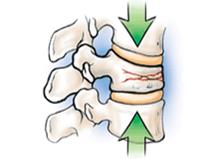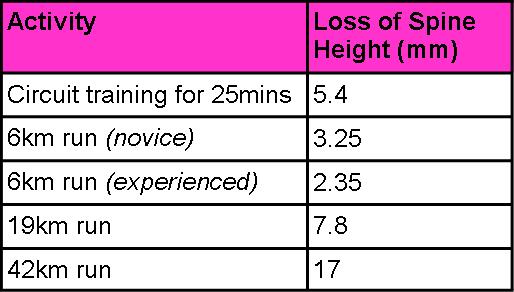 Vertebral column height decreases throughout the day as a result of fluid loss from the discs due to compressive loading. With too much load the discs in the spine lose fluid and become thinner. This makes them an easy target for trauma as they are less able to absorb shock.
Vertebral column height decreases throughout the day as a result of fluid loss from the discs due to compressive loading. With too much load the discs in the spine lose fluid and become thinner. This makes them an easy target for trauma as they are less able to absorb shock.
Greater compression comes from activities such as running, bending, lifting or twisting. Weight training has been shown to increase compressive load in the spine, with dynamic exercises producing greater load than static. During running, force generated at heel strike places approximately three times more load through the spine than walking. Load will increase in magnitude with factors such as distance, experience, intensity and speed.
Below are the results from one study which looked at the loss of spine height after performing the various activities:-


Factors to reduce spinal loading:
 Improved core stability
Improved core stability- Selection of appropriate exercise shoes
- Selection of appropriate exercise surfaces.
- Performing decompression exercises before and after exercise
 See our video showing the Use of the Spinal Back block to decompress your spine!
See our video showing the Use of the Spinal Back block to decompress your spine!
- Timing is important – the spine is better able to absorb load in the morning.
- Correct technique when exercising
If you are experiencing back pain or any other injuries, make an appointment with one of our experienced Physios at PHYSIO4ALL.